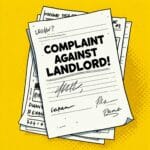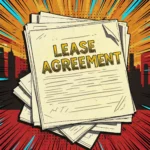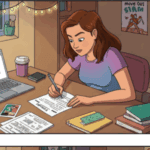How to get your security deposit back after moving out

- How to get your security deposit back after moving out
- Introduction – How to get your security deposit back after moving out
- Before You Begin: Key Considerations for Getting Your Deposit Back
- Essential Supplies for Your Security Deposit Recovery Toolkit
- Step 1: Know Your Rights and Responsibilities as a Tenant
- Step 2: Send a Formal Demand Letter to Your Landlord
- Step 3: Explore Mediation or Local Resources for Resolution
- Step 4: File a Small Claims Lawsuit as a Last Resort
- FAQ – How to get your security deposit back
Introduction – How to get your security deposit back after moving out
An unreturned security deposit can hit your wallet hard, especially for college students in Santa Barbara, California, where the median rent for a one-bedroom apartment is $2,800 as of early 2025, according to Zillow rental data. With security deposits often ranging from $2,800 to $5,600, getting that money back—or at least what’s rightfully yours—matters when you move out. At RepairBoom, we’re here to guide you through how to get your security deposit back from a landlord, focusing on Santa Barbara while including tips for tenants in other states. Our goal is to help you navigate this process realistically, so you can recover what you’re entitled to.
This guide provides four practical steps from our renter move out checklist—knowing your rights and responsibilities, sending a demand letter, exploring mediation or local resources, and filing a small claims lawsuit—to help you recover your deposit. Let’s be real: if you didn’t clean well (e.g., left stains on the carpet) or caused damage beyond normal wear and tear (e.g., holes in the wall), your landlord can deduct those costs, which might be $100–$1,000 or more.
To minimize deductions, check out our renter move out checklist – Moving Out: Your Essential Renter Move-Out Checklist for Young Renters for tips on leaving the rental in good shape, and review your obligations in Renter Responsibilities to understand what’s expected. Let’s dive into the steps to tackle your security deposit dispute Santa Barbara or elsewhere, so you can recover as much as possible.
Before You Begin: Key Considerations for Getting Your Deposit Back
Recovering your security deposit starts with understanding what can realistically be deducted and preparing accordingly – How to get your security deposit back after moving out:
- Cleaning Matters: If you didn’t clean thoroughly—like leaving grease on the stove or trash in the apartment—your landlord can deduct cleaning fees. In Santa Barbara, cleaning costs can range from $250–$700, depending on the rental’s condition and size.
- Damage Deductions: Damage beyond normal wear and tear, such as broken windows, burn marks, or large wall holes, can be deducted. Normal wear (e.g., faded paint after two years) shouldn’t be, but significant damage might cost you $200–$2,000.
- Move-Out Prep: A proper move-out process can minimize deductions. Our Moving Out: Your Essential Renter Move-Out Checklist for Young Renters walks you through cleaning, documenting, and avoiding damage claims to protect your deposit.
- Know Your Responsibilities: Landlords expect you to meet basic obligations, like reporting issues and maintaining the rental. Review Renter Responsibilities to see what might justify deductions if you fell short.
- Documentation: Photos and videos from move-in and move-out can prove the rental’s condition, but they’ll also show if you left it in poor shape, so be honest with yourself.
- Timelines: You’ll need to act within state-specific deadlines (e.g., 30 days after move-out in California) to dispute deductions, or you might lose your chance.
By being realistic about your role, you’ll set the stage to recover security deposit California or in other states, focusing on what you’re legally entitled to.
Essential Supplies for Your Security Deposit Recovery Toolkit
Gather these tools (~$10–$50) to support your efforts to get your security deposit back from a landlord:
- Documentation Tools: Smartphone for timestamped photos, a notebook for logging communications, and cloud storage (e.g., Google Drive) to organize evidence like move-out photos.
- Writing Materials: Paper, pen, or a computer to draft a demand letter, plus access to email or certified mail for sending correspondence.
- Legal Resources: Access to state tenant laws (e.g., California Civil Code § 1950.5 via www.leginfo.legislature.ca.gov), HUD resources (www.hud.gov), and local tenant advocacy contacts.
- Filing Materials: If escalating to small claims court, you’ll need court forms (available online or at courthouses, ~$30–$75 filing fee) and copies of evidence.
These tools will help you build a case for your tenant rights unreturned deposit, but they won’t erase deductions if you’re at fault for damage or poor cleaning. – how to get your security deposit back after moving out.
(Links posted are affiliate sponsored Links and purchases directly support our operation. We stand behind the products we recommend)

Step 1: Know Your Rights and Responsibilities as a Tenant
Understanding your legal rights is key in knowing how to get your security deposit back after moving out—and where you might owe money—is the first step to a realistic security deposit dispute Santa Barbara or in any state. Spend 30–45 minutes researching and assessing your situation.
In Santa Barbara, California, California Civil Code § 1950.5 requires landlords to return your deposit within 21 days of move-out, minus lawful deductions, with an itemized statement and receipts for deductions over $125. Lawful deductions include unpaid rent, cleaning beyond normal wear and tear, or damages exceeding normal use. For example, if you left the apartment with stained carpets or broken cabinet doors, expect deductions of $200–$800, depending on repair costs. Normal wear, like slightly scuffed walls after a year, shouldn’t be deducted.
If your landlord doesn’t follow the 21-day rule or makes unfair deductions, you can dispute it—and potentially recover the deposit plus up to twice the amount as a penalty (e.g., a $3,000 deposit could yield $9,000 if the landlord acted in bad faith). However, if you didn’t meet your responsibilities—like failing to clean or report damage—those deductions are on you. Check Renter Responsibilities to understand what landlords can expect from you.
For tenants in other states, rules differ. In New York, Real Property Law § 7-108 mandates deposit returns within 14 days, and deductions must be justified with evidence. Texas Property Code § 92.109 gives landlords 30 days, but they can be liable for triple the deposit plus $100 if they withhold in bad faith. Research your state’s laws via HUD (www.hud.gov) or state websites (e.g., www.ny.gov for New York).
Be honest: if you didn’t clean well or caused damage, those costs will come out of your deposit. For instance, a Santa Barbara student who left trash and pet stains had $600 deducted—legally—despite disputing it, because the evidence showed their negligence. Review your move-out photos and compare them to move-in photos; if you left the place in good shape, you’re in a stronger position to recover more. Our Moving Out: Your Essential Renter Move-Out Checklist for Young Renters can help you reflect on whether you followed best practices. This step helps you set realistic expectations while identifying any landlord violations.

Step 2: Send a Formal Demand Letter to Your Landlord
A demand letter is your opportunity to formally request your security deposit, but it’s not a guaranteed solution—your landlord can still deduct for valid reasons like damage or poor cleaning, especially since many landlords, particularly in Santa Barbara, are prepared with very detailed inspections. They’ll likely have thorough documentation from their move-out inspection, noting every scratch, stain, or bit of dirt, which means you need to make sure you have a strong case to dispute unfair deductions. Spend 20–30 minutes drafting and sending this letter, ensuring your evidence is solid.
Start by writing a professional letter that includes: (1) your name, address, and move-out date, (2) the deposit amount (e.g., $3,000), (3) the law requiring its return (e.g., California Civil Code § 1950.5 for Santa Barbara tenants, which mandates a return within 21 days), (4) your evidence to counter their inspection findings (e.g., “Photos and a move-out checklist show I left the apartment clean, with no damage beyond normal wear”), and (5) a request for the deposit (or the portion you believe you’re owed) within 7 days, noting potential legal action if ignored.
Be realistic—Santa Barbara landlords often conduct meticulous inspections, so if you know you left damage, acknowledge it but dispute excessive or unfair deductions. For example, “I understand a $200 deduction for the scratched countertop, but the $800 cleaning fee seems excessive given my photos showing a clean apartment.”
To strengthen your case, ensure your evidence directly addresses potential findings from a detailed inspection. Landlords may document specifics like scuff marks, uncleaned appliances, or minor damages (e.g., a cracked light switch cover), which can add up to $300–$1,000 in deductions if you’re not prepared. Compare your move-out photos and checklist—refer to our Moving Out: Your Essential Renter Move-Out Checklist for Young Renters for guidance on what to document—with your move-in condition to prove what’s normal wear (e.g., faded paint) versus damage you caused (e.g., a hole in the wall).
Send the letter via certified mail with a return receipt (~$4–$7 at USPS) to create a legal record, or email it with a read receipt if your landlord prefers digital communication. For Santa Barbara tenants, you might write, “Under California Civil Code § 1950.5, you were required to return my $3,000 deposit by [date]. Photos and my move-out checklist show the apartment was left clean, though I acknowledge a small deduction for a scratched countertop.
However, the $800 cleaning fee seems excessive given the evidence.” For tenants in other states, adjust the legal reference—e.g., in Texas, cite Texas Property Code § 92.109, which also allows penalties for bad faith. Document the submission with a timestamped photo of the mailed letter or an email screenshot, as this can support your case if you need to escalate. This step often prompts landlords to respond, but don’t expect the full amount if their detailed inspection shows you’re responsible for damage or cleaning issues.

Step 3: Explore Mediation or Local Resources for Resolution
If your landlord doesn’t return your deposit or makes unfair deductions, mediation or local resources can help resolve the issue without court—but deductions for your mess or damage will likely stand. Spend 30–60 minutes exploring these options.
In Santa Barbara, contact the Santa Barbara Rental Housing Mediation Program, a free service offered by the City of Santa Barbara (www.santabarbaraca.gov/services/housing/mediation). They mediate disputes, including security deposit issues, helping both parties reach a fair agreement. For example, a UCSB student who left minor wall scuffs had $150 deducted but negotiated down an additional $500 cleaning fee through mediation, recovering $2,350 of her $3,000 deposit. If you suspect discrimination (e.g., based on race or disability), contact the California Civil Rights Department (CRD) at www.calcivilrights.ca.gov, as withholding deposits for discriminatory reasons violates the Fair Housing Act.
For tenants in other states, similar resources exist. In New York, the Attorney General’s Tenant Helpline (1-833-499-0343, www.ag.ny.gov) offers mediation, while Texas tenants can reach out to the Texas Tenants Union (www.txtenants.org). Nationally, HUD (www.hud.gov) provides guidance on deposit disputes, especially if federal laws are violated. Be prepared: if mediation confirms you owe for damages (e.g., a broken mirror), you’ll only recover the remaining deposit. Document all mediation outcomes, as they can support a court case if needed. This step can save you $50–$200 in court fees and resolve issues in 1–2 weeks, per LegalZoom.

Step 4: File a Small Claims Lawsuit as a Last Resort
If mediation fails and your landlord still withholds your deposit unfairly, small claims court can help recover what’s owed—but you’ll only get what’s legally yours after valid deductions. Allocate 1–2 hours to prepare and file your case.
In Santa Barbara, file at the Santa Barbara County Small Claims Court (www.sbcourts.org, filing fee: $30–$75). California Civil Code § 1950.5 allows you to sue for the deposit plus up to twice the amount as a penalty for bad faith (e.g., a $3,000 deposit could yield $9,000 if the landlord acted improperly). Complete the SC-100 form, detailing your claim, and attach evidence: move-out photos, lease, demand letter, and landlord responses.
Serve the landlord with the papers (~$20 via sheriff) and attend the hearing (30–70 days later). A Santa Barbara tenant sued after her landlord withheld $1,500 for “cleaning” despite evidence of a spotless apartment—she won $1,500 plus $2,000 in penalties, but a $500 deduction for a broken door was upheld.
For tenants in other states, the process varies. In New York, file in Small Claims Court (filing fee: $15–$20, www.nycourts.gov), where Real Property Law § 7-108 allows penalties for bad faith. In Texas, file under Texas Property Code § 92.109 (filing fee: $50–$75, www.txcourts.gov), where you can seek triple the deposit plus $100 for bad faith. Nationally, small claims courts handle claims up to $5,000–$10,000. At the hearing, present your evidence and argue your case, but expect deductions if you caused damage. This step ensures you recover what’s fair, though court fees and time (1–3 months) apply, as noted by FindLaw.
FAQ – How to get your security deposit back
How long should I wait for my security deposit in Santa Barbara?

California Civil Code § 1950.5 requires Santa Barbara landlords to return your deposit within 21 days of move-out, with an itemized list of deductions. If they don’t, you can dispute it—but expect deductions if you left damage or didn’t clean well .
What can a landlord legally deduct from my deposit?

Landlords can deduct for unpaid rent, cleaning beyond normal wear (e.g., $200 for stained carpets), or damages like broken fixtures ($300–$800). Normal wear, like faded paint, isn’t deductible.
What evidence do I need to get my security deposit back from a landlord?

Move-out photos, your lease, a move-out checklist, and landlord communications are key. They’ll show if you left the place clean, but also reveal if you’re at fault for damage, impacting your security deposit dispute Santa Barbara
Can I sue my landlord if they don’t return my deposit?

Yes, file in small claims court if mediation fails. In California, you can sue for the deposit plus up to twice the amount as a penalty ($30–$75 filing fee). But you’ll only recover what’s left after valid deductions
What are my options if I’m not in California?

Tenants in New York can use the Attorney General’s Tenant Helpline (1-833-499-0343), while Texas renters can contact the Texas Tenants Union (www.txtenants.org). Small claims court is an option, but deductions for damage or cleaning will apply

How to replace a smoke alarm battery | Free Guide – RepairBoom
How to unclog a drain in 4 easy steps | Free Guide – RepairBoom


